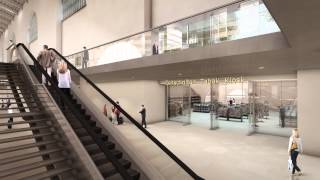A project goes deep
Project update Main Station Stuttgart
-
7 / 7
Project update October 2015 – Main Station Stuttgart, Germany
5. The Main Station Stuttgart is a core part of the comprehensive large-scale railway and urban development project Stuttgart 21 that will create some 57km of new railways, including 30km of tunnels and 25km of high-speed lines.
Extensive construction work for the Global Holcim Awards Gold 2005 winning urban redevelopment and railway realignment project starts in October 2015. One of the main project tasks is to construct a new underground hall of railway platforms that will form the hub of the rail network, that will feature distinctive chalice-shaped concrete pillars.
Last updated: October 16, 2015 Stuttgart, Germany
Extensive construction work for this urban redevelopment and railway realignment project starts in October 2015, just to the south of where the new Stuttgart Main Station will be built. To keep noise levels for residents as low as possible, acoustic barriers up to ten meters high will be erected before construction work commences. One of the main project tasks is to construct a new underground hall of railway platforms that will form the hub of the rail network.
The design features distinctive chalice-shaped concrete pillars: a test pillar one-eighth of the final size is being tested adjacent to where excavators are preparing the first pit for the underground platforms. Eventually, 27 of the “chalice pillars” which form large “light eyes” to allow daylight to enter the railway platform hall while supporting the roof.
After testing, the model pillar will be dismantled. The aim of the exercise is to become familiar with the complex structure of the chalice and to gain experience in forming the material. Particular attention has been given to the concrete which is produced in a purpose-built factory on site. In addition to color, the finished surface must meet high demands.
 The construction of the pillar took eight weeks, excluding preparatory work for the molds and structural reinforcement (rebar). Both are complex and unique in form which would not have been possible without computer aided design: “We are constantly working on the 3D model,” says Michael Pradel, director of the section around the main railway station in the Deutsche Bahn Projekt Stuttgart - Ulm (PSU). “All of them will be similar, but there are no two pillars that will be 100 percent identical,” he says, describing the challenges of construction.
The construction of the pillar took eight weeks, excluding preparatory work for the molds and structural reinforcement (rebar). Both are complex and unique in form which would not have been possible without computer aided design: “We are constantly working on the 3D model,” says Michael Pradel, director of the section around the main railway station in the Deutsche Bahn Projekt Stuttgart - Ulm (PSU). “All of them will be similar, but there are no two pillars that will be 100 percent identical,” he says, describing the challenges of construction.
In the coming weeks, the concrete will also be tested for its durability. A cast of the concrete slab will be exposed to 1200 degree flames over several hours in a test facility in Leipzig, to ensure the structure’s resilience in the event of an accident. If the testing proves successful, construction will commence on the first support pillars next year.
Tunnel work using specialized excavators to accommodate the railway lines approaching the station will start in January 2016.
/c(282-1.33333333333333-100-5.5096987205943-0)/201510_projectupdate_mainstationstuttgart-1.jpg) A new station for the city railway
A new station for the city railway
The construction work for an underground city railway (S-Bahn) stop that will be directly linked to the Main Station is currently progressing as well, starting with the excavation of the construction area to link the tunnels to the new “Staatsgalerie” stop. To make room for the construction site, all traffic around the station will be diverted for approximately 18 months.
General facts about the project
The Main Station Stuttgart is a core part of the comprehensive large-scale railway and urban development project Stuttgart 21 integrating the city into the Trans-European highspeed railway network between Paris and Vienna. It will create some 57km of new railways, including 30km of tunnels and 25km of high-speed lines.
The new concept will change the current terminus Main Station into an undergroud “through station” with eight tracks. Due to the improved efficiency of the configuration, the new station will have greater capacity for trains, thus coping with the increasing passenger demand and ensuring fast, convenient connections in the regional and national train traffic. The relocation of the rail into the ground will open up around 100 hectares of land in the inner city to use for other purposes. Completion is scheduled for 2021.

